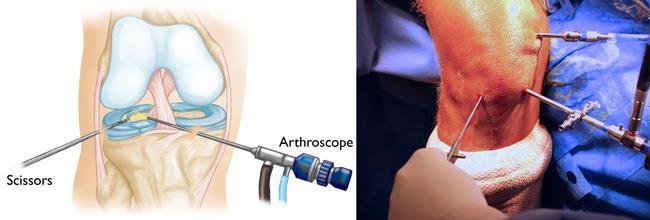Knee Arthroscopy

Overview
Knee arthroscopy is a minimally invasive surgical procedure that can diagnose and treat issues within the knee joint. This procedure is performed by inserting a tiny camera, called an arthroscope, into the knee joint, which allows your doctor to view the joint without making a large incision. Knee arthroscopy is used to treat several knee-related problems, and it’s less invasive compared to open forms of surgery.
Types
While the procedure of knee arthroscopy remains the same, it can be performed to address different types of knee problems. These include:
-
- Torn anterior or posterior cruciate ligaments (ACL or PCL)
-
- Torn meniscus
-
- Knee bones out of place or misaligned
-
- Swollen synovium (lining of the joint)
-
- Fractures in the knee bones
Causes
The issues that lead to needing knee arthroscopy are often caused by acute or chronic knee injuries. Acute injuries might be caused by direct impact to the knee, or from twisting, bending, or falling. Chronic knee problems can result from wear and tear over time, leading to degenerative conditions like osteoarthritis.
Symptoms
If you are experiencing the following symptoms, you may be suffering from an issue that can be addressed by knee arthroscopy:
-
- Knee pain, especially when bearing weight
-
- Stiffness or loss of mobility in the knee
-
- Swelling around the joint
-
- Popping or grinding noises in the knee during movement
-
- Knee instability or weakness
Diagnosis
Your doctor will warrant a knee arthroscopy based on physical examination findings, and the results of imaging tests such as X-rays, MRI, or CT scans. These procedures provide a detailed image of your knee, helping doctors identify the problems effectively.
Treatment Options
Non-Surgical Management
Depending on the extent of your knee issue, non-surgical interventions may be suggested first. These can include:
-
- Physical therapy or rehabilitation exercises
-
- Pain medications or anti-inflammatory drugs
-
- Rest, ice, compression, and elevation (RICE) protocol
Surgical Management
When non-surgical management doesn’t provide enough relief, or the knee damage is too extensive, a knee arthroscopy might be suggested. The procedure is performed under anesthesia and generally lasts between 30 to 60 minutes depending on the severity of the knee problem.
During the procedure, small incisions will be made, and saline solution will be pumped into your knee to expand the joint and allow for better visibility. An arthroscope will be inserted, and the surgeon will use the images sent back to a screen to guide their treatment. Depending on what is discovered, tiny surgical instruments can be used to repair or remove problematic tissue or debris.
After surgery, an individual is often allowed to return home the same day.
Living With Knee Arthroscopy
After knee arthroscopy, most people experience significant relief from knee pain and improved knee function. Recovery time can vary depending on the extent of the procedure, but a rehabilitation program may be recommended to help regain strength and mobility in the knee.
It’s important to follow your surgeon’s instructions for wound care, exercise, and medications. Regular check-ups may be arranged to monitor your progress.
When to Seek Help
If you suspect you might require a knee arthroscopy, consult with a healthcare professional. Seek immediate medical help if you experience severe pain, cannot bear weight on your knee, notice an obvious deformity or have severe swelling.
Also, if you have already undergone knee arthroscopy, report any symptoms such as fever, persistent or increased pain, redness, or drainage from the surgical site as it can indicate complications like infection.
Wrapping up, knee arthroscopy is an effective and minimally invasive way to treat several knee issues. It’s important to stay informed and engage in clear discussions with your healthcare provider for the best possible outcome.
